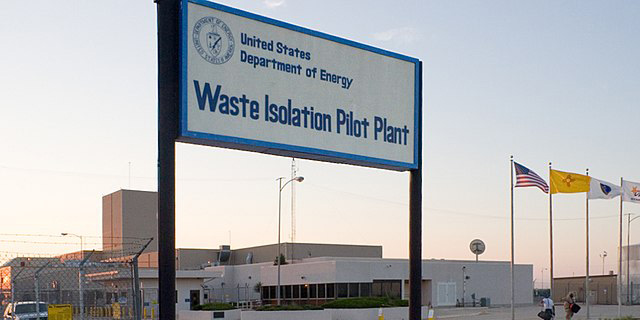Concrete blocks are loaded onto a metal base and transporter during tests on a gantry crane system that will lift replacement melters for Hanford’s WTP. (Photo: DOE)
The Department of Energy has announced that tank operations contractor Washington River Protection Solutions (WRPS) and subcontractor Atkins are making progress at the Hanford Site in Washington state in their preparations to provide replacement melters to treat radioactive and chemical tank waste for the site’s Direct-Feed Low-Activity Waste program.
Contractors scan floors inside Jana Elementary School in Missouri during testing done in October 2022. (Photo: USACE/JP Rebello)
New legislation that would require the cleanup of Jana Elementary School in suburban St. Louis was introduced in the Senate by Sen. Josh Hawley (R., Mo.). The Justice for Jana Elementary Act would also order the United States Army Corps of Engineers (USACE) to test all properties in the Hazelwood School District, of which Jana Elementary is a part.
The Waste Isolation Pilot Plant in southeastern New Mexico. (Photo: DOE)
Waste management startup Deep Isolation announced that it has entered into a mentor-protégé agreement with Salado Isolation Mining Contractors (SIMCO), the new Bechtel National–led management and operations contractor for the Department of Energy’s Waste Isolation Pilot Plant in New Mexico.
The La Crosse site in 2019 with major decommissioning completed. The coal-fired Genoa plant is in the background. (Photo: EnergySolutions)
The Nuclear Regulatory Commission announced that it has released the site of the La Crosse boiling water reactor in Wisconsin for unrestricted public use. The action comes after the NRC found that EnergySolutions subsidiary LaCrosseSolutions had met the agency’s radiation protection standards in decommissioning the nuclear power plant.
A 3D view of the TN Eagle used fuel cask. (Image: Orano)
Orano Group subsidiary Orano NPS announced that Swiss electrical utility Axpo has selected the company to provide its TN Eagle used nuclear fuel casks over the entire operating period of the Leibstadt nuclear power plant in Switzerland.
February 17, 2023, 3:03PMRadwaste SolutionsPeter Swift, Michael Apted, Lake Barrett, John Kessler, and Steven Nesbit An electric continuous miner machine cuts out a waste-emplacement panel at the Waste Isolation Pilot Plant salt repository in New Mexico. (Photo: DOE)
Used nuclear fuel and high-level radioactive wastes are by-products of nuclear energy production and other applications of nuclear technology, and the consensus approach to disposing of those wastes safely is to encapsulate them and emplace them in stable geologic formations (geologic repositories) where they will be isolated from people and the environment for very long periods of time. The federal government has established environmental standards for waste isolation that any proposed geologic repository must meet.
In July 2021, the American Nuclear Society established a special committee to consider possibilities for revised generic environmental standards for disposal of spent nuclear fuel and high-level radioactive waste in the United States. The committee developed a number of recommendations, which are contained in a draft report that was to be issued in February for review and comment by stakeholders. The draft report can be found on the ANS website, at ans.org/policy/repositorystandard/.
The committee’s draft recommendations are based on two underlying assumptions. First, that the relevant legislative framework for regulation defined in the Nuclear Waste Policy Act (NWPA) remains unchanged. Specifically, it is assumed that the Environmental Protection Agency will be charged with promulgating environmental standards for disposal and that the Nuclear Regulatory Commission will be charged with reviewing applications for disposal facilities using licensing requirements and criteria consistent with the EPA standards. Second, that existing generic disposal standards will be updated or replaced.
Two empty waste tanks weighing more than five tons each were transported from outside the Hanford Site’s Effluent Treatment Facility to an on-site landfill. (Photo: DOE)
Two large tanks near the Effluent Treatment Facility (ETF) at the Department of Energy’s Hanford Site in Washington state were removed recently to make way for future wastewater treatment activities at the ETF.
Savannah River’s DWPF has completed the conversion from formic acid to glycolic acid in the waste vitrification process. (Photo: DOE)
The Defense Waste Processing Facility (DWPF) at the Department of Energy’s Savannah River Site (SRS) in South Carolina has resumed operations after a completing a processing improvement that the DOE said will enable safer operations and more efficient vitrification of radioactive waste.
The Waste Isolation Pilot Plant in southeastern New Mexico. (Photo: EPA)
Salado Isolation Mining Contractors (SIMCO), a single-purpose entity comprised of Bechtel National and Los Alamos Technical Associates as a teaming contractor, has assumed responsibility for managing and operating the Waste Isolation Pilot Plant in New Mexico.
A rendering of ISP’s proposed interim storage facility in West Texas. (Image: ISP)
A federal appeals court rejected a lawsuit brought by environmental groups challenging the Nuclear Regulatory Commission’s licensing of a consolidated interim storage facility (CISF) for spent nuclear fuel in Andrews County, Texas. The U.S. Court of Appeals for the D.C. Circuit found that the NRC reasonably applied its hearing regulations when approving Interim Storage Partners’ (ISP) license for the facility.















